 |
 |
 |
 |
| |
||||
No More GlassesA CBS 2 News Special Assignment 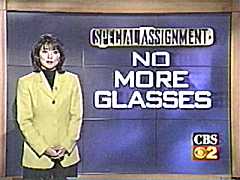 Ask anyone who can't see up close and they'll tell you how frustrating it is. Ask anyone who can't see up close and they'll tell you how frustrating it is. But a brand new medical procedure may help clear up this fuzzy problem. Patients are saying after just seconds under a laser, they were able to throw out those darn reading glasses. CBS 2 News' Thelma Gutierrez goes to Tijuana to learn more about a quick fix eye surgery that has baby boomers running to the border. CBS 2 News' Special Assignment: No More Glasses aired Saturday, February 21, 1998 at 11: p.m. When people pass one of life's milestones -- age 40 -- they might have to deal with a world that's starting to look a little fuzzy. Some of them will do anything to get their vision back. Christann Manning, from Idaho, was so anxious to get rid of her glasses she was willing to travel hundreds of miles to find a way to do it, reported CBS 2 News' Thelma Gutierrez. "Once I turned forty, one of the biggest problems I had is I needed reading glasses," Manning told Gutierrez. Folks are willing to make the trip to get a highly sought-after procedure called hyperopic lasik, a laser treatment that could end Manning's dependence on reading glasses. According to Gutierrez, there are people who even come from back east with their doctors because their doctors are interested in this procedure -- which isn't yet available in the U.S. "In the U.S. alone, there are 50 million people who could benefit from these treatments of farsightedness," Dr. Arturo Chayet told Gutierrez. After measurements were made of Manning's eye, the natural lens was peeled back. Dr. Chayet then sculpted the surface of her cornea, making it a little more curved and a little more powerful with the use of a laser, said Gutierrez. Twenty-six seconds later, Manning's cornea was reshaped, giving her the opportunity to do what she's been longing to do -- get rid of her glasses. Just days before leaving for Tijuana for his surgery, Jose Garcia learned that the hyperopic lasik procedure was approved for FDA trials in the U.S. Forty-nine-year-old Garcia switches from one pair of glasses to his reading glasses all day long. "Once you're forty, the world hits you with a hammer over the head," Garcia told Gutierrez. "As we grow older, our eyes are less useful. At 42, 43, that's when the lights started to dim on me." Dr. Kerry Assil from the Sinskey Eye Institute in Santa Monica performed Garcia's surgery. There is a potential risk to the hyperopic lasik procedure. It has the biggest infection rate as far as eye surgeries go, but surprisingly less than regular use of contact lenses. The surgery does however, have a 95 percent effectiveness rate when it comes to eliminating farsightedness completely. After 56 seconds under the excimer laser, Garcia's world literally came into focus. "For me to get up and see the clock on the wall, to look at my watch and see my watch," Garcia said. "I guess is something you don't expect right away, it's very emotional." Dr. Assil will report his findings from this first procedure to the FDA, but it will be another year before hyperopic lasik is available to the general public, said Gutierrez. For more information on LASIK, take a look at the following resources:
|
|
 |
|

 |
||
|
12 p.m.
Woman 2 Woman One of the stars from "Judging Amy" 5 p.m. 6 p.m. 11 p.m.
|
||
 |
||
|
4-5 p.m.
Judge Judy Ruler Of The Free World! 8:00 p.m. 8:30 p.m.
9:00 p.m.
|
||
| |
||
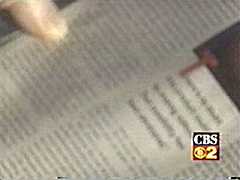 Not being able to focus in on anything without your reading glasses used to be viewed as just tough luck -- until now. A new medical technique may make those glasses obsolete.
Not being able to focus in on anything without your reading glasses used to be viewed as just tough luck -- until now. A new medical technique may make those glasses obsolete. 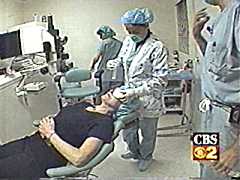 Manning's frustration with her reading glasses is just one of the reasons that is sending so many people to the Codet Eye Institute in Tijuana.
Manning's frustration with her reading glasses is just one of the reasons that is sending so many people to the Codet Eye Institute in Tijuana. 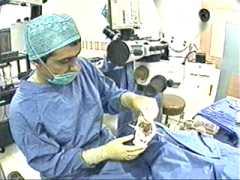 Over the past couple of years, 400 patients have had their farsightedness corrected in Tijuana. Seventy percent of them were American, said Gutierrez.
Over the past couple of years, 400 patients have had their farsightedness corrected in Tijuana. Seventy percent of them were American, said Gutierrez. 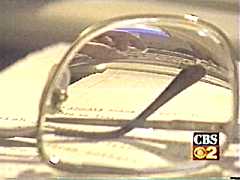 Garcia canceled his travel plans to Tijuana so he could be one of the first patients to have this procedure done in the U.S. instead.
Garcia canceled his travel plans to Tijuana so he could be one of the first patients to have this procedure done in the U.S. instead. 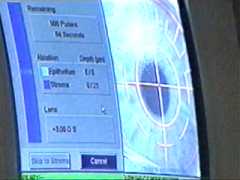 "At his age to be farsighted is frustrating," Dr. Assil told Gutierrez. "His world is blurry far away and up close. What we will do for him is strike up the best of all worlds."
"At his age to be farsighted is frustrating," Dr. Assil told Gutierrez. "His world is blurry far away and up close. What we will do for him is strike up the best of all worlds." 

